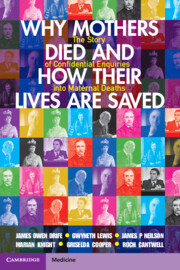 Why Mothers Died and How their Lives are Saved
Why Mothers Died and How their Lives are Saved Published online by Cambridge University Press: 05 April 2023
Hypertension associated with proteinuria occurs in pre-eclampsia, which can progress to eclampsia (convulsions) and is a major cause of maternal death globally. CEMD Reports reminded doctors that high blood pressure may have other, much rarer, causes. Early diagnosis is important but in the 1950s signs of pre-eclampsia were sometimes taken lightly, allowing eclampsia to occur. The 1979-81 Report recommended that each region should have a specialist team to advise about preventing respiratory and clotting complications. Adherence to guidelines required a major culture shift. Deaths from these complications almost disappeared and by the year 2000 the main cause of death was brain haemorrhage. The Report emphasised the need for prompt administration of antihypertensive drugs. In 1995 a controlled trial showed that magnesium sulphate, the treatment favoured in the USA, was more effective than UK treatments for eclampsia. In 2002 the MAGPIE trial, led by Prof Lelia Duley in Oxford and involving 10,000 women in 33 countries, showed that it is also effective in pre-eclampsia. The rate of fits has fallen and, since 2010, the number of deaths has been in single figures.
To save this book to your Kindle, first ensure [email protected] is added to your Approved Personal Document E-mail List under your Personal Document Settings on the Manage Your Content and Devices page of your Amazon account. Then enter the ‘name’ part of your Kindle email address below. Find out more about saving to your Kindle.
Note you can select to save to either the @free.kindle.com or @kindle.com variations. ‘@free.kindle.com’ emails are free but can only be saved to your device when it is connected to wi-fi. ‘@kindle.com’ emails can be delivered even when you are not connected to wi-fi, but note that service fees apply.
Find out more about the Kindle Personal Document Service.
To save content items to your account, please confirm that you agree to abide by our usage policies. If this is the first time you use this feature, you will be asked to authorise Cambridge Core to connect with your account. Find out more about saving content to Dropbox.
To save content items to your account, please confirm that you agree to abide by our usage policies. If this is the first time you use this feature, you will be asked to authorise Cambridge Core to connect with your account. Find out more about saving content to Google Drive.